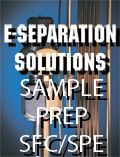Technology Forum: Sample Prep SFC/SPE
Joining us for this discussion are Terry Berger of Aurora SFC Systems, Inc.; Todd Palcic of TharSFC, a Waters Company; DJ Tognarelli of JASCO, Inc.; and Elena Gairloch of Biotage.

With the ACN shortage showing no signs of letting up in the near future, sample prep has become more critical than ever to the productivity of the modern separations lab. Whether moving away from solvents altogether with SFC, or conserving them in SPE, this is a topic that is currently on the minds of many analytical chemists.
Joining us for this discussion are Terry Berger of Aurora SFC Systems, Inc.; Todd Palcic of TharSFC, a Waters Company; DJ Tognarelli of JASCO, Inc.; and Elena Gairloch of Biotage.
What impact has the acetonitrile shortage had on the use of SFC? SPE? Do you believe this impact will be lasting or is it temporary?
Berger:The acetonitrile shortage will have little impact on SFC. We have seldom used it in the past. It's greatest utility came from its transparency in the UV down to 195nm, which may be important for compounds with very weak chromophores. I also recall a few cases where solutes reacted with alcohols making acetonitrile an obvious alternative.
HPLC users will undoubtedly switch many new methods to methanol or ethanol, but they are stuck with all those methods approved by the FDA. Acetonitrile is inherently fairly toxic. I would guess there will be a general movement away from acetonitrile and it will mostly be used only in those regulated markets. Lower usage should bring the price down at least somewhat.
I suppose the regulated methods will accelerate the penetration of UHPLC or just smaller ID columns, in order to use lower volumes of acetonitrile.
Since chromatographers will need to change their traditional approach (reversed phase with acetonitrile/water) this may actually give them an additional incentive to try SFC. I should point out that 3µm particles in SFC are about as fast as 1.8µm particles in UHPLC, and require lower pressures, like those in traditional HPLC's!
Palcic: I believe that there will be a continued shift away from acetonitrile towards the new high pressure/low volume HPLC and CO2-based SFC technology. SFE will play more of a role when government regulations or solvent expenses increase to a point that instrumentation companies like us see the market for a more compact and automated platform. If hexane/heptanes prices return to last year’s levels for an extended period of time, then labs will look for environmentally friendly and inexpensive ways to operate technologies like SFE.
Tognarelli: The “green” aspect of SFC has always appealed to chromatographers, but the recent acetonitrile shortage and the associated dramatic price increase further expanded the interest of previously unexplored markets. Although acetonitrile supplies may be at normal levels by as early as the second half of this year, current economic trends regarding production of materials, of which acetonitrile is a by-product, suggests prices may remain at currently inflated levels.
Gairloch: Some methods have been redeveloped due to the ACN shortage and alternative solvents such as MeOH have been explored. Certainly the higher cost of the Acetonitrile has driven users to analyze the overall need for it and to look at viable alternatives. The impact is likely to last for some time.
What trends do you see emerging in Sample Prep SFC?
Berger:SFC is going mainstream but mostly in chiral separations. I think this is going to change as we develop more sensitive instrumentation. This should open up QA/QC applications that have simply not been there before. Also, SFC is an ideal separation technique for natural products including TCM's. It has really surprised me that SFC hasn't taken off in this field since SFE is used so extensively in it. The fact that you can easily make very long columns with low-pressure drops ought to appeal to anyone with complex samples.
SFC will remain a strong force in chiral separations, in part because it is scalable. With increased sensitivity, combining chiral and achiral trace analysis will become routine.
Palcic:I see a large number of companies trying to enter the SFC space now because there are so few growth areas in the instrumentation industry these days.
Tognarelli:We are noticing a significant expansion of interest in SFC applicability, particularly outside of well-established areas (i.e., chiral purifications and small molecules), especially regarding those purifications that normally require long method times, consume large volumes of solvent, and produce large volumes of waste. The trend is taking advantage of the “green” attributes of SFC, while increasing lab efficiency by utilizing the speed of SFC in reducing analysis time.
What is the future of Sample Prep SFC? SPE?
Berger:I believe in the long run SFC will simply be considered the way to do normal phase HPLC, using the same hardware for both normal and reversed phase. As I have often said, SFC is normal phase chromatography on steroids, with none of the traditional problems, and applicable to much more polar solutes.
SFC should become a major technique for any small molecule samples. Penetration into new QA/QC and regulated applications will be critical for this to happen. The instrumentation must be robust and easy to validate. I think we are getting there.
Palcic:This answer could take up 10 pages of your magazine. In short, SFC will dominate the separation of chiral molecules for preparative applications in the short term and analytical applications in the long term. Beyond that, SFC is likely to take a large percentage of the overall small molecule preparative market space and eventually play a larger role in analysis of metabolites, flavors and fragrances, petrochemicals, biofuels, pesticides, insecticides, and fertilizers.
Tognarelli:As SFC becomes more commonplace in laboratories, we foresee a more open access style of sample analysis of both chiral and achiral purifications, thereby expanding the use beyond analytical chemistry.
Gairloch: In my opinion, the future is strong for automated sample preparation because we continue to look for ways to process more samples or look at more compounds in a shorter amount of time.
What application do you see growing the fastest in Sample Prep SFC? SPE?
Berger:I believe increased sensitivity is the key to opening up a broad range of new applications for SFC.
Palcic:Purification of achiral small molecule discovery compounds as a general tool replacing older/retiring HPLC preparative systems in pharmaceutical and university laboratories.
Tognarelli:As mentioned, the speed of SFC has led to research in its applicability of samples requiring long analysis times, such as proteins and peptides, especially with the ability of SFC to front-end an MS. In addition, preparative SFC offers a distinct advantage in the post run natural escape of CO2, leaving fractions more easily recoverable in small volumes of organic solvents.
Gairloch: Food Safety is certainly a popular one. Health and environmental issues, such as pharmaceuticals in the water and melamine continue to expand.
What is one change/improvement you hope to see in the Sample Prep SPE or SFC industry over the next few years?
Berger:I hope to see SFC become a mature technology without the proprietary software, and the "garage shop" kludges forced on small instrument companies by limited financing and low volumes.
Palcic:The market will see more SFC instruments integrated with high definition mass spectrometry, SFE and SFC instruments capable of flash chromatography–like performance and an all-in-one general purification platform combining SFC and HPLC systems to provide a total solution.
Tognarelli:As more manufacturers begin exploring the SFC market and awareness of SFC increases, it is our hope that the use of SFC expands to support a greater variety of standard chromatography applications.
Gairloch: I believe that users will be looking for SPE methods that do not require evaporation and reconstitution. This is an important step in the extraction process and by eliminating it many can prevent analyte loss and reduce processing time significantly.
If you are interested in participating in any upcoming Technology Forums please contact Assistant Editor Meg Evans for more information.
Best of the Week: Food Analysis, Chemical Migration in Plastic Bottles, STEM Researcher of the Year
December 20th 2024Top articles published this week include the launch of our “From Lab to Table” content series, a Q&A interview about using liquid chromatography–high-resolution mass spectrometry (LC–HRMS) to assess chemical hazards in plastic bottles, and a piece recognizing Brett Paull for being named Tasmanian STEM Researcher of the Year.
Using LC-MS/MS to Measure Testosterone in Dried Blood Spots
December 19th 2024Testosterone measurements are typically performed using serum or plasma, but this presents several logistical challenges, especially for sample collection, storage, and transport. In a recently published article, Yehudah Gruenstein of the University of Miami explored key insights gained from dried blood spot assay validation for testosterone measurement.
Determination of Pharmaceuticals by Capillary HPLC-MS/MS (Dec 2024)
December 19th 2024This application note demonstrates the use of a compact portable capillary liquid chromatograph, the Axcend Focus LC, coupled to an Agilent Ultivo triple quadrupole mass spectrometer for quantitative analysis of pharmaceutical drugs in model aqueous samples.
